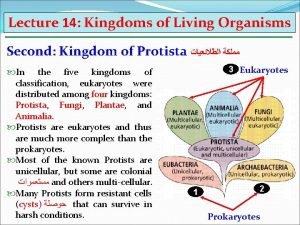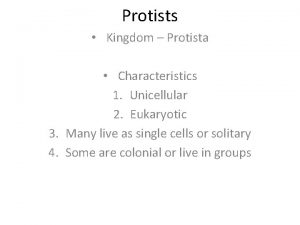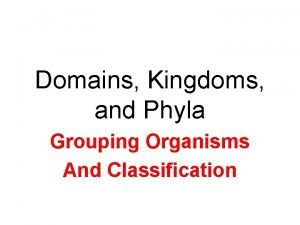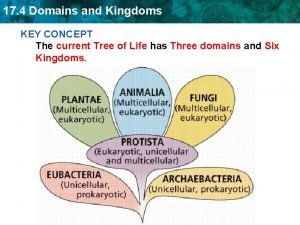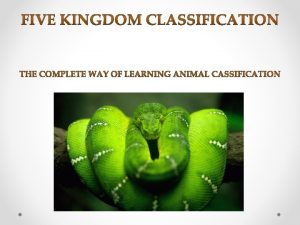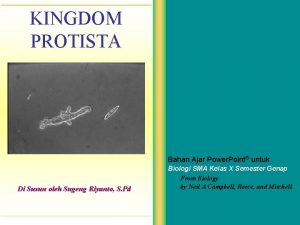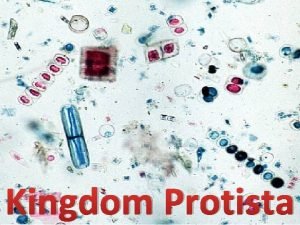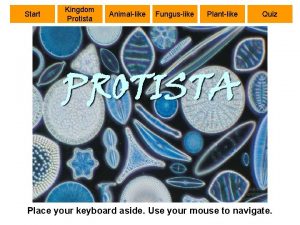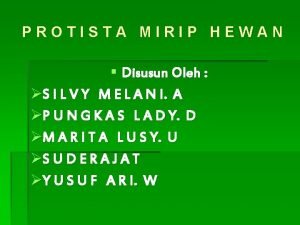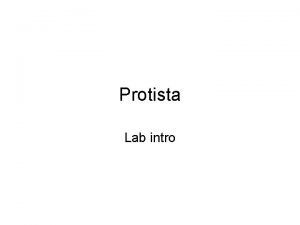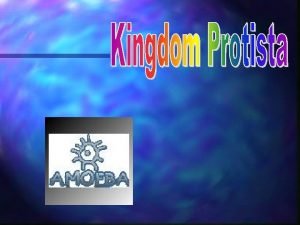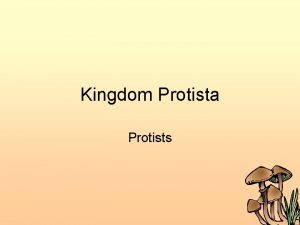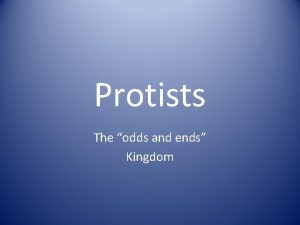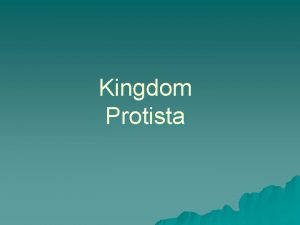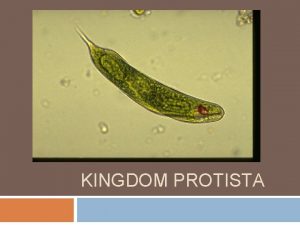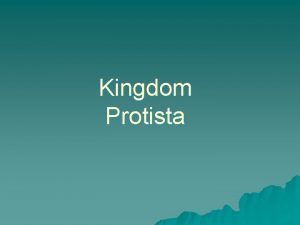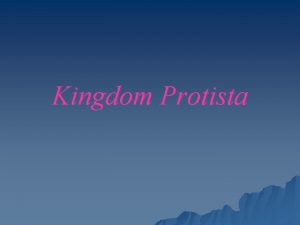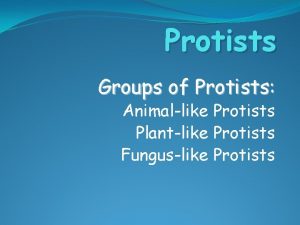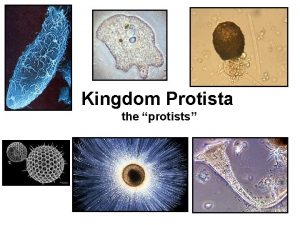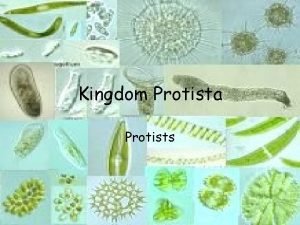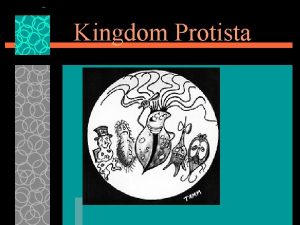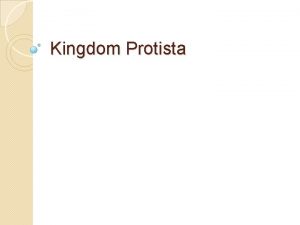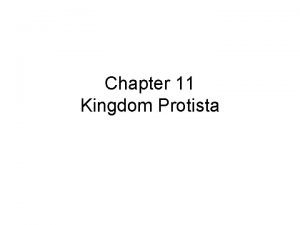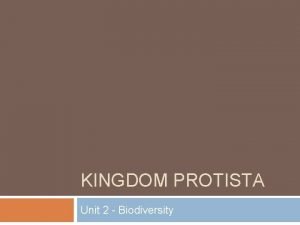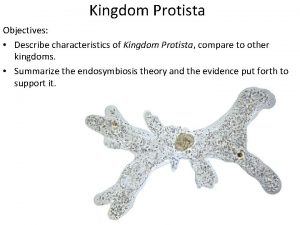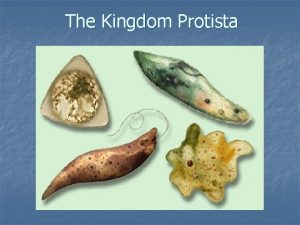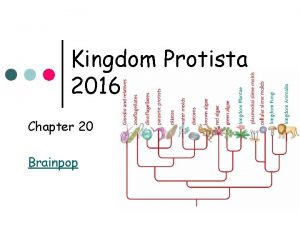What Are Protists Kingdom Protista odds and ends






















- Slides: 22

What Are Protists? • • Kingdom Protista “odds and ends” Eukaryotic organisms Heterotroph, autotroph, or decomposer

• Several important characteristics: – membrane-bound organelles – complex cilia and flagella – sexual reproduction with gametes – Multi – cellularity

Reproduction • Asexually by binary fission, budding, and fragmentation • Sexually by fusion of gametes

Sexual Reproduction • Occurs as a response to environmental stress • Zygospore – Adaptation that allows the zygote to survive freezing, drying out, and sun exposure • Multicellular protists can reproduce both sexually and asexually via alternation of generations. – consists of multi - cellular haploid and multi - cellular diploid phases.

Classifying Protists • How they obtain nutrition – Photosynthesis – Breakdown organic material – Capture and eat other protists • Ecological role

Animal – Like Protists • Protozoa “first animals” • Ingest other organisms to obtain energy • Unicellular, most can move, and most reproduce asexually by binary fission

Amoeboid Protists • Move by using extensions of their cells called pseudopodia – Pseudopodia are also used to surround and engulf food particles • Live in fresh water, in salt water, and in soil • Free-living, but some are parasites

Ciliates • Some of the most complex single - celled organisms • Most or all of the body is covered by short, hair - like structures called cilia • Move and hunt for food by beating their cilia

Flagellates • Protists that have whip-like structures called flagella. • Some flagellates also have cilia or form pseudopodia. • Can be free-living or parasitic

Sporozoans • Animal-like protists that form spore – like cells when they reproduce • They lack flagella, cilia, and pseudopodia and do not move. • All sporozoans are parasitic and cause diseases. (Malaria)

Plant – like Protists • Include the organisms known as phytoplankton and algae. • Obtain energy through photosynthesis • Vary in the types of pigments used in photosynthesis and the kinds of molecules used to store energy • Diatoms, Dinoflagellates, algae

Diatoms • Photosynthetic, unicellular protists with unique double shells • Their shells are made of silica or calcium carbonate and have distinct patterns.

Dinoflagellates • Unicellular protists that typically have two flagella. • Most are photosynthetic, but some are heterotrophic • Most have protective coats that contain silica.

Euglenoids • Freshwater protists that have one or two flagella. • Many are photosynthetic, heterotrophic, or both. • Some have an eyespot that helps direct them toward light.

Red Algae • Most are multicellular and are usually found in warm ocean waters. • The pigments in red algae absorb blue light that penetrates deep into water. • Red algae grow at greater depths than other algae. • Some have calcium carbonate in their cell walls. – These coralline algae play an important role in the formation of coral reefs.

Brown Algae • Multicellular protists that are found in cool ocean environments. • The largest brown algae are kelp that can reach 60 m (197 ft) in length. • The body of a kelp has is made up of a holdfast, a stipe, and blades

Green Algae • Very diverse group of protist that form a major part of marine plankton. • Some inhabit damp soil and resemble plants. • Some are symbiotic within the cells of other organisms. • Use chlorophyll for photosynthesis, starch to store energy, and their cell walls contain cellulose.


Fungus – like Protists • Absorb nutrients from their environment and reproduce by releasing spores. • Slime Molds • Water Molds and Downy Mildews

Protists and Humans • Dysentery – Contaminated water – Giardia, amebiasis • Toxoplasmosis – Litter boxes and uncooked meat – Flu – like symptoms

• Trichomoniasis – Very common S. T. I • Cryptosporidiosis – Dysentery from uncooked meat and contaminated water • Chagas disease – Kissing bug feces – Few to no symptoms then can become chronic with heart failure, swollen esophagus and large intestine

Protists and the Environment • Oxygen production and nutrient recycling – Produce at least half of the Earth’s oxygen • Food webs – Primary producers • Algal blooms – Red tide and eutrophication • Protists symbiosis – Coral, lichen, ungulate digestion
 Odds and ends kingdom
Odds and ends kingdom Antigentest åre
Antigentest åre Old kingdom middle kingdom new kingdom
Old kingdom middle kingdom new kingdom Nnn ruled
Nnn ruled Youtube egypt
Youtube egypt Capital of egypt during the old kingdom
Capital of egypt during the old kingdom مملكة البلازموديوم
مملكة البلازموديوم Protista ex
Protista ex Are algae plants or protists
Are algae plants or protists Kingdom protista
Kingdom protista 3 domain 6 kingdom
3 domain 6 kingdom Concept mapping chapter 17 domains and kingdoms answer key
Concept mapping chapter 17 domains and kingdoms answer key Kingdom monera classification chart
Kingdom monera classification chart Animalia fungi plantae
Animalia fungi plantae Kingdom protista ppt
Kingdom protista ppt Domain eukarya kingdom protista
Domain eukarya kingdom protista Characteristics of kingdom protista
Characteristics of kingdom protista Paramecia use _________ to move and capture food.
Paramecia use _________ to move and capture food. Protists
Protists Phyrophyta
Phyrophyta Sarcodina habitat
Sarcodina habitat Prokaryotic protista
Prokaryotic protista How do all members of the phylum ciliophora move
How do all members of the phylum ciliophora move






